
Revell 1/144 Airbus A.320
| KIT #: | 04861 |
| PRICE: | $20.99 |
| DECALS: | One livery, five serial options |
| REVIEWER: | Scott Van Aken |
| NOTES: |

| HISTORY |
The Airbus A320 family consists of short- to medium-range, narrow-body, commercial passenger jet airliners manufactured by Airbus. The family includes the A318, A319, A320 and A321, and the ACJ business jet. The A320s are also named A320ceo (current engine option) after the introduction of the A320neo. Final assembly of the family in Europe takes place in Toulouse, France, and Hamburg, Germany. Starting in 2009, a plant in Tianjin, China, has also been producing aircraft for Chinese airlines. In April 2013, Airbus started construction of a new production facility for the A319, A320, and A321 variants in Mobile, Alabama. The aircraft family can accommodate up to 220 passengers and has a range of 3,100 to 12,000 km (1,700 to 6,500 nmi), depending on model.
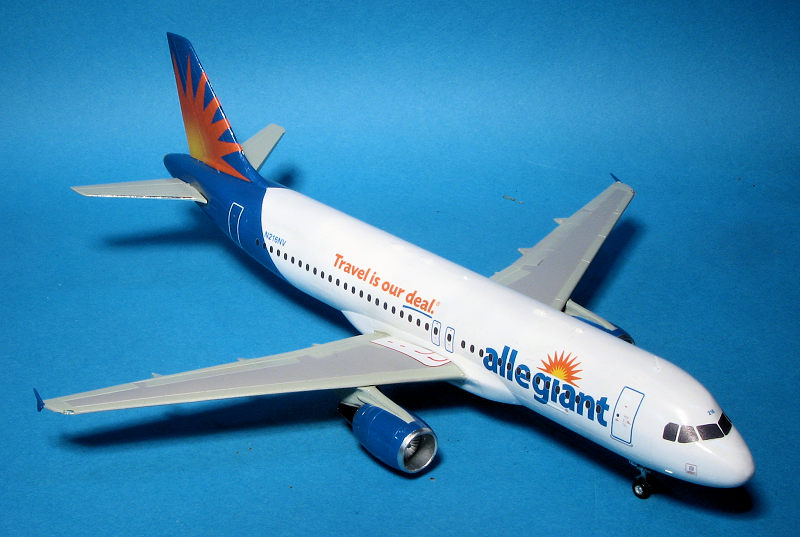 The first member of the A320 family—the A320—was
launched in March 1984, first flew on 22 February 1987, and was first delivered
in 1988. The family was soon extended to include the A321 (first delivered
1994), the A319 (1996), and the A318 (2003). The A320 family pioneered the use
of digital fly-by-wire flight control systems, as well as side-stick controls,
in commercial aircraft. There has been a continuous improvement process since
introduction.
The first member of the A320 family—the A320—was
launched in March 1984, first flew on 22 February 1987, and was first delivered
in 1988. The family was soon extended to include the A321 (first delivered
1994), the A319 (1996), and the A318 (2003). The A320 family pioneered the use
of digital fly-by-wire flight control systems, as well as side-stick controls,
in commercial aircraft. There has been a continuous improvement process since
introduction.
In December 2010, Airbus officially launched the new generation of the A320 family with the A320neo "New Engine Option". The new generation offers a choice of the CFM International LEAP-X or Pratt & Whitney PW1000G, combined with airframe improvements and the addition of winglets, named Sharklets by Airbus. The aircraft will deliver fuel savings of up to 15%. Virgin America will be the launch customer for the aircraft in spring of 2016. As of December 2011, a total of 1,196 A320neo family aircraft have been ordered by 21 airlines making it the fastest ever selling commercial aircraft.
As of July 2013, a total of 5,677 Airbus A320 family aircraft have been delivered, of which 5,481 are in service. In addition, another 4,135 airliners are on firm order. It ranked as the world's fastest-selling jet airliner family according to records from 2005 to 2007, and as the best-selling single-generation aircraft programme. The A320 family has proved popular with airlines including low-cost carriers such as EasyJet who purchased A319s, and A320s, to replace its Boeing 737 fleet. The aircraft family competes directly with the Boeing 737, 717, 757 and the McDonnell Douglas MD-80.
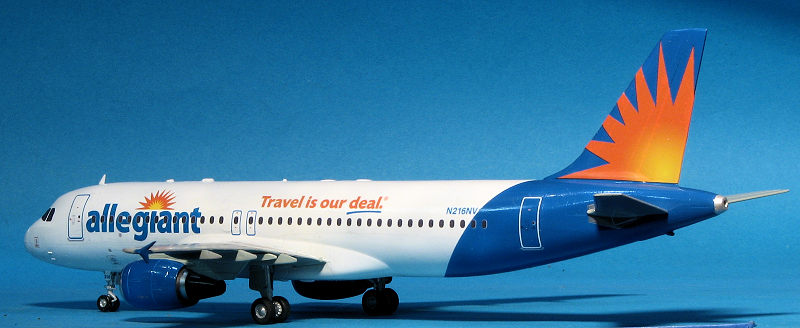 Allegiant Air is an American low-cost airline owned
by Allegiant Travel Co. that operates scheduled and charter flights. Allegiant
Travel Company is a publicly traded company with 2,848 employees
and over $2.6 billion USD market capitalization. The corporate headquarters are
in Summerlin, Nevada, a suburban community of Las Vegas. It has been reported
that Allegiant Air is four times more likely to have in-flight failures than
major airlines. The subject of this build was delivered in 2000 to Iberia Air
Lines who then sold it to Allegiant in 2013.
Allegiant Air is an American low-cost airline owned
by Allegiant Travel Co. that operates scheduled and charter flights. Allegiant
Travel Company is a publicly traded company with 2,848 employees
and over $2.6 billion USD market capitalization. The corporate headquarters are
in Summerlin, Nevada, a suburban community of Las Vegas. It has been reported
that Allegiant Air is four times more likely to have in-flight failures than
major airlines. The subject of this build was delivered in 2000 to Iberia Air
Lines who then sold it to Allegiant in 2013.
Allegiant Air is also the only airline operating out of Mid-America St Louis Airport a few miles from my house. This airport has had the dubious distinction of being featured on NBC's "Fleecing of America" more than once. Initially costing local taxpayers about 313 million dollars, for which the county has been tossing 8-11 million dollars a year down this rat-hole (most of it to pay the debt for building it), the county stupidly restructured the debt increasing the time it takes to pay it off and adding several additional millions of dollars to the total. Since opening in 1997, the airport has never made a profit and has never earned even a tenth of its annual operating costs. Inexplicably, the man in charge is paid a bonus every year on top of his considerable salary. It is ranked 323rd among US passenger airports.
| THE KIT |
This is not the first kit of the A320 family that Revell has kitted as they have done at least the A.321 in the past. With that in mind, modelers of this aircraft will not be surprised to find that many of the sprues and parts are the same between the two planes. This one basically differs in the fuselage for the shorter A.320. As a result, I was not surprised to find more flash than one would expect on a modern kit.
In line with most airliners, there is no cockpit or
cabin detail. There are two ways to mold fuselages. One is with the myriad of
cabin windows and the other is with a smooth fuselage. Revell seems to be in the
initial camp, though unlike some companies, it does not include cabin windows,
which would be a real chore to mask. Though there is no cockpit, there is a nose
gear well that needs to be installed along with a
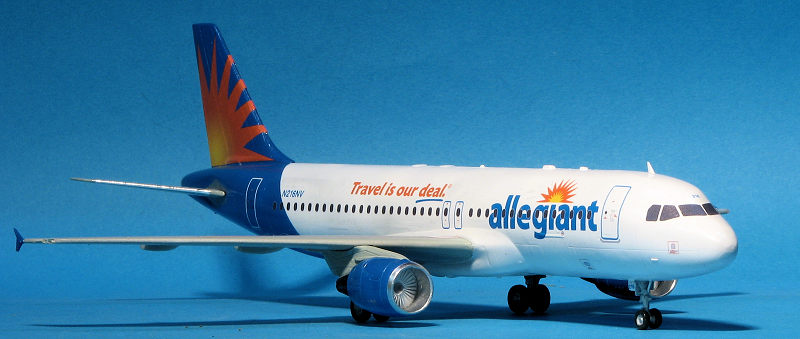 whopping 20 grams of weight if
doing the kit on the ground. An in-flight option is provided though you will
have to come up with your own stand.
whopping 20 grams of weight if
doing the kit on the ground. An in-flight option is provided though you will
have to come up with your own stand.
Since this uses the wing of the A.321, you have to remove a lot of small fairings from the underside of the wing. This aircraft uses the CFM 56 turbofans so be sure to pick the proper engine nacelles as two sets are offered. Landing gear appear to be quite sturdy for those of you doing your plane on the deck. A number of antennas are also part and parcel of airliners and this one is no exception. Clear bits are pretty well limited to the cockpit glass and wing tip lights.
Instructions are typical Revell, providing only Revell paint references, requiring some of the colors to be mixed. The markings are for any one of five registration numbers; four of them German and one Swiss. The color scheme is basically red and white with all the red bits needing to be painted. Wings and stabs are in greys with metal leading edges, as are the leading edges of the fin and engine intakes. The red and silver cheat lines are part of the decals and making a scan of them to provide a mask will help in getting all the red bits in the right place on the fuselage. Decals are very nicely done and based on my experience with new Revell AG decals, will work without any issues.
| CONSTRUCTION |
So that I'm not constantly whining about the excessive amount of flash and generally crappy fit throughout the article, let me just say that this kit has both, which is odd as it is a fairly recent tooling and not something from the 1960s (which would be amazing as the plane didn't exist back then). Needless to say, all this caused the kit to be a lot slower build than it may have otherwise been and was enough to have me simply walk away from it (and other builds) for several weeks.
This kit re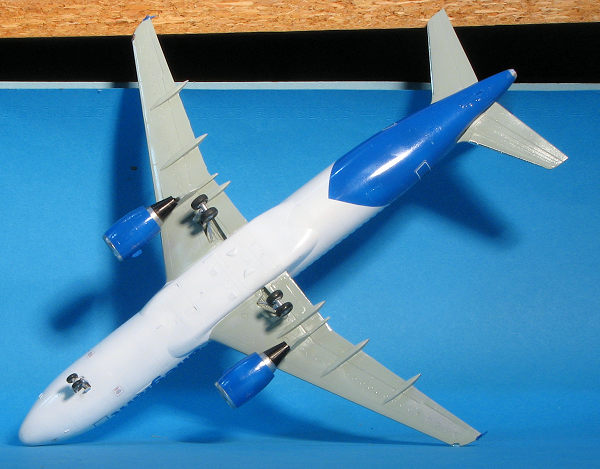 quires you to install the nose gear well
and gear prior to closing the fuselage halves, though I did not have any issues
regarding breakage during the build. Something that was time consuming was
filling all the cabin windows. I did this mainly because frequently one
airline's window arrangement is not the same as the other and the aftermarket
sheet I bought has windows. Anyway, I put a strip of plastic behind the window
run and filled the holes with epoxy putty. This has the benefit of not
shrinking, but can be much more difficult to sand down. Considerable time was
spent on this aspect of things. Before getting really involved with sanding, I
put the required 20 grams of weight in the nose and when I closed the fuselage
halves, I installed the cockpit windows as well.
quires you to install the nose gear well
and gear prior to closing the fuselage halves, though I did not have any issues
regarding breakage during the build. Something that was time consuming was
filling all the cabin windows. I did this mainly because frequently one
airline's window arrangement is not the same as the other and the aftermarket
sheet I bought has windows. Anyway, I put a strip of plastic behind the window
run and filled the holes with epoxy putty. This has the benefit of not
shrinking, but can be much more difficult to sand down. Considerable time was
spent on this aspect of things. Before getting really involved with sanding, I
put the required 20 grams of weight in the nose and when I closed the fuselage
halves, I installed the cockpit windows as well.
After much sanding, it was ready for me to mate the wings. The wings are a simple enough assembly on paper. Once the wings had been treated, I found they did not want to fit too well. There is a need to do much trimming and test fitting to get a decent fit. During this time, I also assembled the engines. The pylons are handed so be sure to be careful when gluing on the small finlet on the inside of each engine housing. I should mention that the little spike that sticks out the back of each engine was a bit of a pain to get in there straight thanks to mold misalignment.
Once the wings and engines were built up, it felt like a good time to do some painting.
| COLORS & MARKINGS |
First thing I did was to primer everything. Thanks to what
has to be too much mold release, I had some issues with the paint sticking. I
ended up sanding all those areas and repainting. For the engines, I used several
shades of metallic from the Alclad II line, masking each shade after painting
it. On the fuselage, there were many coats of Tamiya gloss white applied. I
masked off the back of the fuselage and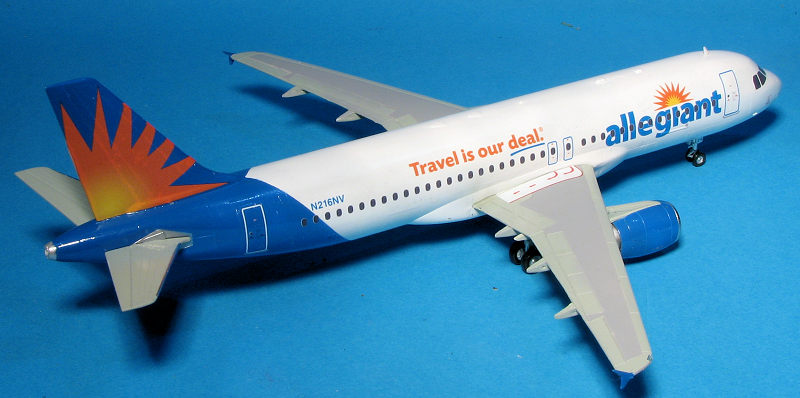 fin, giving them and the engine housings
a coat or two of French Blue. The decal sheet (from Draw Decals) recommends Testors Oldsmobile Engine Blue, but as I had just run out of it, I used the
French Blue. On the wings, I left the Tamiya grey primer for the corrogard
areas, masking that off and later painting the rest of the wings, tail planes,
and gear doors with Testors light aircraft grey (as I don't have any Airbus grey
and unless someone imports it, I'll never have any. Not going to spend $25 to
have two tinlets of paint shipped from Europe).
fin, giving them and the engine housings
a coat or two of French Blue. The decal sheet (from Draw Decals) recommends Testors Oldsmobile Engine Blue, but as I had just run out of it, I used the
French Blue. On the wings, I left the Tamiya grey primer for the corrogard
areas, masking that off and later painting the rest of the wings, tail planes,
and gear doors with Testors light aircraft grey (as I don't have any Airbus grey
and unless someone imports it, I'll never have any. Not going to spend $25 to
have two tinlets of paint shipped from Europe).
The wings and rear fuselage were masked (airliners require a lot of masking) while the area around the tailplanes was painted aluminum, the wing tip finlets painted blue, and the overspray on the fuselage repainted. During all this, I cleaned up the landing gear and wheels, painting them in the process. As you can imagine, I did make a goof. I forgot to remove the additional flap track bits from the underside of the wings. That was duly removed and then repainted.
Once everything was done, it was time for decals. For
this I used Draw Decals. I've had mixed results with these, one set being
hopelessly too transparent, breaking up and refusing to conform to tight bends.
That was not the case this time. Perhaps they have changed their printing method
or something, but these worked just like standard water slide decals except that
they are on a common carrier and have to be cut. For sure, the blue on the
fuselage markings is pretty transparent, but that is not an issue once applied
to the white surface. The tail markings also fit well and while not totally
opaque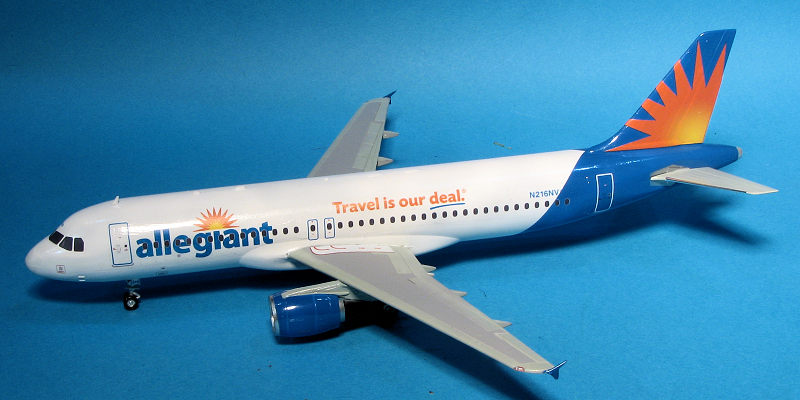 , worked out well. I did cut through some of the rays on the tail to make
sure it would fit well onto the contours of the lower fin. All of the side
markings are one long decal. These were lined up with the fore and aft doors. No
issues with wrinkles or folding as I used a lot of water. The decals reacted
well to Microsol.
, worked out well. I did cut through some of the rays on the tail to make
sure it would fit well onto the contours of the lower fin. All of the side
markings are one long decal. These were lined up with the fore and aft doors. No
issues with wrinkles or folding as I used a lot of water. The decals reacted
well to Microsol.
Moving on to the final bits. The main landing gear was then attached. The retraction strut piece is particularly difficult to install properly. I ended up having to glue that in first, then the main gear strut, then use tweezers to carefully attach the retraction mechanism to the strut. I also had to shorten the axles a bit to get the wheels to fit fully. The gear doors were then attached.
Before attaching the engines, I did some research as to whether the leading edges of the wings were bare metal. The decal instructions do not show it and make it a point to say that the leading edge of the fin was NOT bare metal. Looking at a lot of photos of this plane in this livery did not seem to show anything on the wings. However, it did seem like the tailplanes had bare metal so I used Bare Metal Foil on those. Those were then attached as were the wing tip lights (which don't fit worth a hoot) and some antennas.
| CONCLUSIONS |
What I thought would be a decent build was not and much of this is thanks to all the crud on the parts that made getting this kit built more like doing an early short run kit. While the end result is pleasing enough, I seriously cannot recommend this kit unless you can be assured of a clean pressing. I should also point out that on the Draw Decals, there is a decal for the area around the tail plane attachment. It is smaller than what is engraved on the kit, making me think that perhaps the sheet is designed around the Zvezda kit (which I have not seen).
| REFERENCES |
http://en.wikipedia.org/wiki/Airbus_A320
https://en.wikipedia.org/wiki/Allegiant_Air
17 March 2017
Thanks to me for picking this one up.
If you would like your product reviewed fairly and fairly quickly, please contact the editor or see other details in the Note to Contributors.